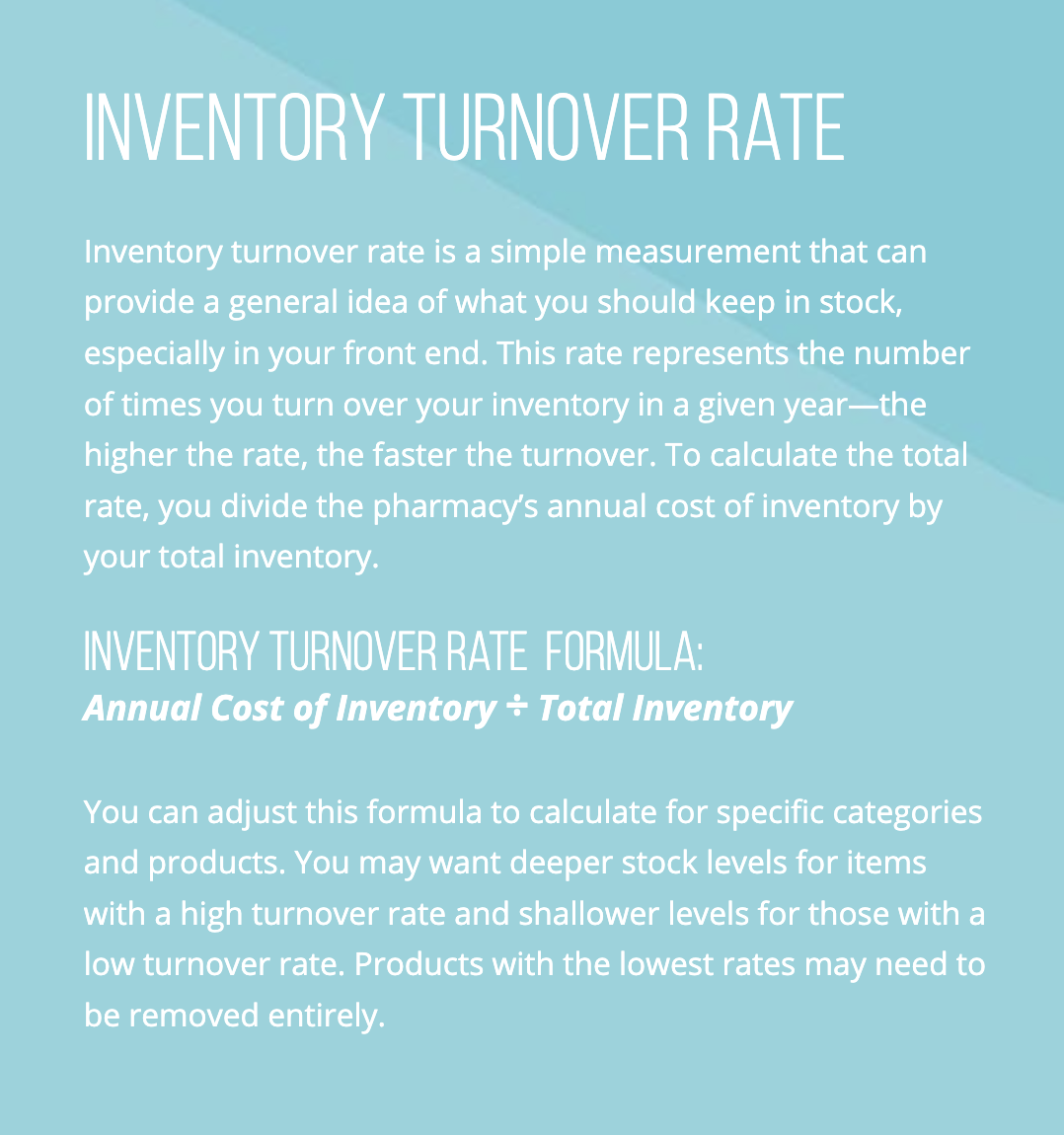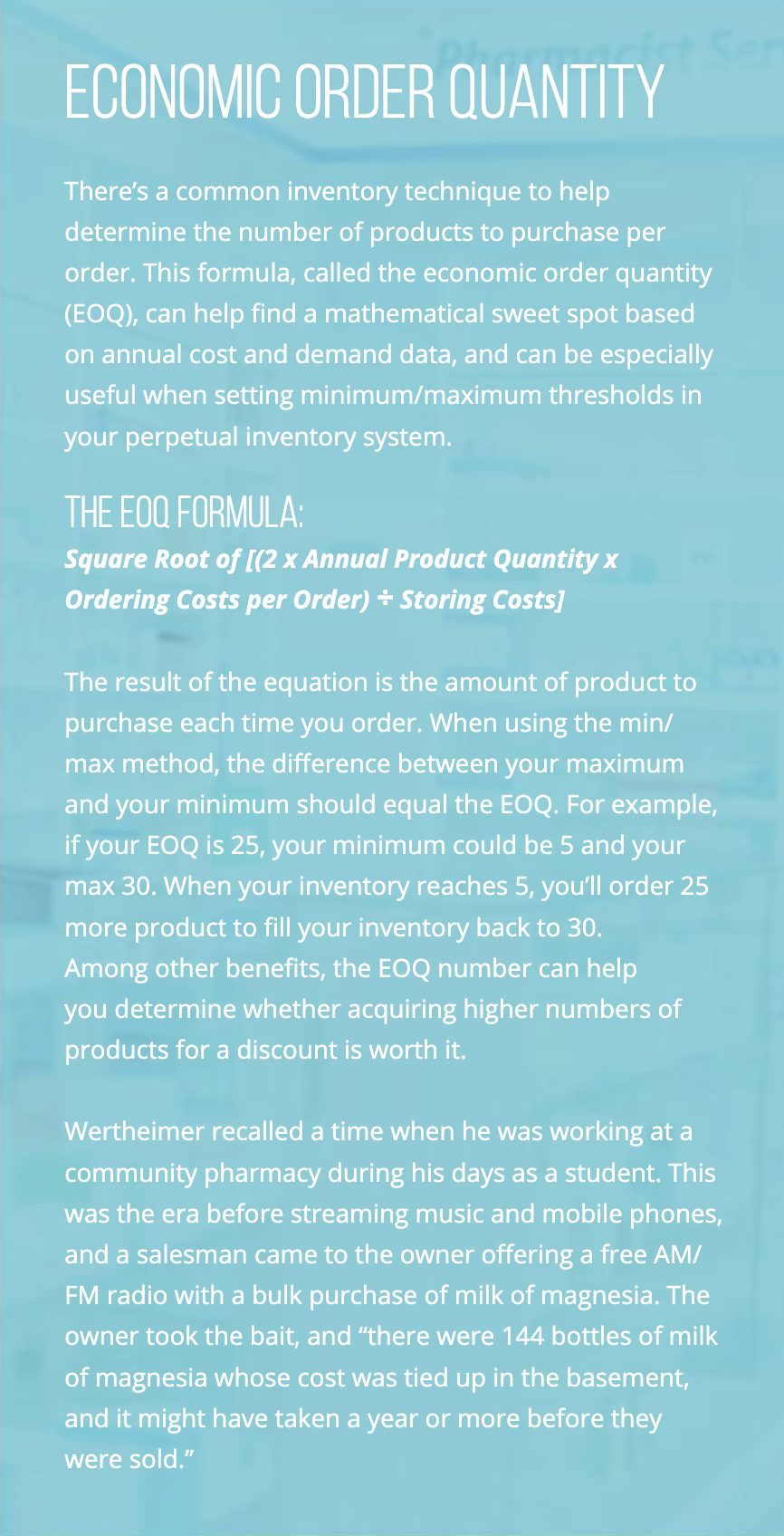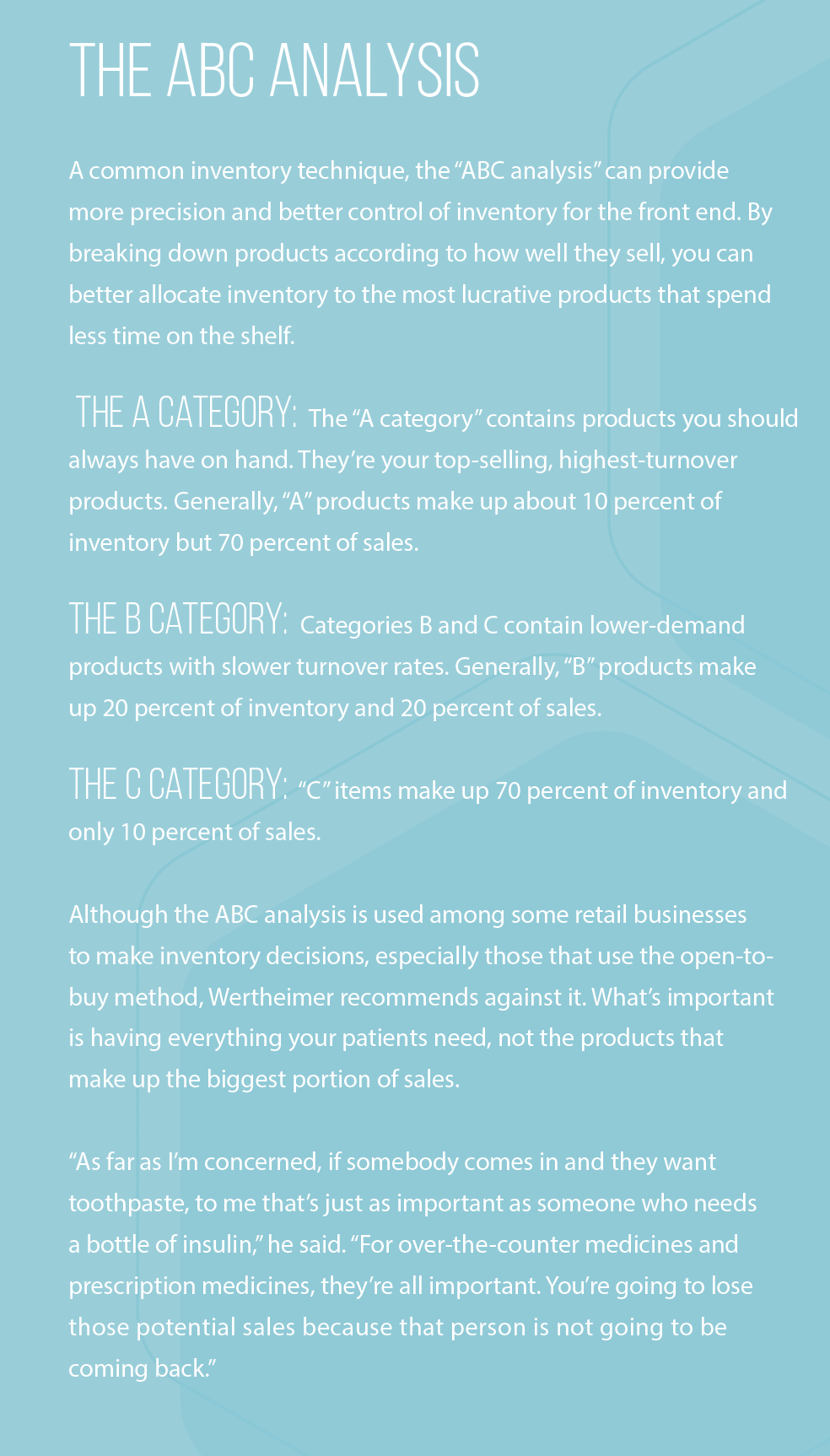Inside: Pharmacy inventory management techniques to increase cash flow and profitbaility.
Every retailer’s business depends on inventory. The better you manage the flow of goods, the more money you make and the more cash you have on hand to grow your business.
Although that’s the name of the game for all retailers, a pharmacy’s inventory can be especially consequential, not only for the health of patients but also for the health of the business. At any given time, a pharmacy may be carrying upwards of 1,500 NDCs, with a single bottle of prescription medication tying up as much as $5000. That enormous financial risk requires impeccable management to mitigate.
“I’ve never seen someone manage a pharmacy well who doesn’t have control of their inventory,” said pharmacy owner Huy Duong, who manages around 1,300 NDCs a month at his store, Dale’s Pharmacy, in Fort Lupton, Colorado. “If you’re not managing your inventory correctly, you’re leaving a lot of money on the table.”
That $5000 medication makes up only one type of inventory cost, called carrying costs, which are any expenses associated with keeping products on the shelf. These include the opportunity costs of having cash tied up in inventory, which could otherwise be spent on business improvements, investments, prompt payments, or any other endeavor that could be earning you money.
But there are other inventory costs as well, like the wages for employees who prepare and submit orders, receive and verify shipments, stock the products, and monitor and maintain the inventory. “Time is money,” Duong said. “If it costs you in time, then it costs you money, and eventually you don’t get back what you put in.”
Then there are shortage costs, which include any loss associated with not having a product when a patient needs it. Although these costs aren’t as easily measured, they are significant. “If you lose a customer, it’s not just that sale,” said Albert I. Wertheimer, PhD, professor of pharmacy economics at Nova Southeastern University College of Pharmacy. “The typical shopper spends around $3,000 or $4,000 a year in the store.”
Mastering pharmacy inventory management can help you minimize these costs, free up cash flow, and keep your pharmacy in the black. “It can make the difference between profitability and loss,” Wertheimer said. “To understand inventory control is absolutely critical.”
The Costs of Pharmacy Inventory
1. Ordering costs:
These are the costs associated with placing an order, receiving and verifying the order, and putting away the stock. These costs may take up a lot of your pharmacy staff’s time, which could be spent on other tasks that increase revenue or build patient loyalty.
2. Carrying costs:
These are the the costs associated with keeping products on the shelf, such as fees, taxes, insurance, shrinkage, perishability, obsolescence, and employee labor for maintaining and monitoring stock. They also include the opportunity costs of having cash tied up in inventory.
3. Shortage costs:
These are the costs of lost sales due to not having the inventory on hand when you need to fill the prescription. This cost is the hardest to quantify, but often the easiest to see. The more often you have shortages, the more you lose in sales, customers, and expedited shipping.
Methods of pharmacy inventory management
Although the consequences of pharmacy inventory management are steep, the goal is simple: “Have the correct amount of inventory in stock and on the shelves for what’s needed and no more or no less,” Wertheimer said. But that doesn’t mean it’s easy—far from it. “It’s like walking on a tightrope. You can’t do it initially, you have to learn from experience.”
Various methods have been developed for determining how much product you need and when you’ll need it. In the past, pharmacists would have to physically look through shelves, take notes by hand, and manually input order quantities. When they noticed a product was getting low, they’d put in an order. That method has many monikers—seat-of-the-pants, just-in-time—but it is essentially measuring on the fly, waiting until the product is nearly out before putting in a manual order.
Although some still use that method, Wertheimer said that “smarter, more progressive” pharmacies these days have perpetual inventory systems that track all the inventory in real time and automatically send orders to wholesalers according to predetermined order points. Duong says these systems are essential: “Perpetual inventory is a necessity if you really want to succeed in managing inventory.”
Even with a perpetual system, Wertheimer emphasized the importance of doing a physical inventory check once or twice per year, which enables pharmacies to identify and account for theft or loss of products. “The only way you can get credit for missing bottles on your taxes at the end of the year is to indicate that there’s been a shrinkage,” he said, “and that adds up to a pretty hefty sum.”
Duong’s team performs daily cycle counts when the system notifies them of discrepancies, which can occur for several reasons, such as a manufacturer error or a misplaced bottle. “When they see a discrepancy as it comes along, they fix it immediately or they figure out where that medication is,” Duong said. They also spot check about once every two weeks during periods of down time. The pharmacy’s inventory count is usually spot-on, Duong said, because they use automatic pill counters.
Cycle count: auditing products to verify the correct amount of inventory
Perpetual systems track inventory and send orders automatically, but a person still has to determine the reorder points and quantities for the system, which are the decisions that make or break inventory management. So the question remains: how much product should you order and how often should you order it?
One strategy, often called the open-to-buy method, creates a monthly buying budget based on your planned sales. Unlike the just-in-time ordering method, open-to-buy is proactive and ensures you have enough for the entire month to meet demand. This budgeted approach based on financial forecasting helps you ensure the return on investment is greater than the cost, which Wertheimer said is crucial. “Let’s say you get two percent savings in your bank. If you buy something and don’t get three percent on that investment putting that bottle on the shelf, then the answer is you don’t need it. You shouldn’t buy it,” he said.
Open-to-buy formula: Planned Sales + Planned Markdowns + Planned End of Month Inventory – Planned Beginning of Month Inventory
Another strategy, often called the minimum/maximum method, determines a minimum and maximum number of products you want in your inventory at any given time. Your inventory never drops below the minimum or goes above the maximum. This method focuses on keeping inventory at consistent economic levels. Instead of ordering a budgeted amount every month, you continually order based on real-time stock levels so you’ll always have stock available without going overboard.
Know your patients
No matter which method you use, you need to know your pharmacy and your patients. “The biggest error is really not knowing your clientele and not customizing things for change of season or aging of community and things like that,” Wertheimer said. He suggests using data from the current month a year prior. Decisions about inventory in December this year, for instance, should be guided by the sales data from December of last year.
Because shortages could cost you a patient, Wertheimer recommends erring on the side of excess. It’s worse to not have a product than to have too many. This is especially true for a fledgling pharmacy that depends on customer growth and doesn’t yet have enough data for optimal order quantities. “You really don’t know what your typical array of sales is going to be until you get to a steady state where the same people come in for the same things,” he said.
Having been around since 1982, Dale’s Pharmacy has developed a steady stream of patients that Duong can rely on. This enables him to base his inventory almost entirely on his current clientele. Rather than planning certain quantities and timing based on general sales data and estimates, he stocks what his current patients already have prescriptions for and schedules the orders based on their refill dates. These maintenance drugs from current patients account for the majority of his stock. “If you’ve never had a patient on a specific product, why would you carry it? It’s a waste of your inventory,” Duong said. “It’s more important to focus on who you have than to try to prepare for potential patients.” If more than one patient is using the same medication, Duong typically keeps a two-week supply available if it’s a generic and a one-week supply if it’s a brand name—unlike generics, brands are always available and have price stability.
In Duong’s experience, having a prescription medication out of stock when a new patient walks in doesn’t necessarily result in a lost customer. Most are willing to wait, and for those who need it that day, Duong recommends contacting other pharmacies for the patient and directing them there. “If a patient comes in for the first time and needs a medication same-day, I think if you shouldered that burden, called around other pharmacies, even competitors, and you let that patient know you’ll start carrying that product for them, I think that patient is going to give you another shot. They’re going to be highly impressed.”
For Duong, all of these strategies are more guidelines than law. Managing pharmacy inventory is more art than math, he said. “With more than 1,300 drugs per month, I can’t go the same route for each and every drug we carry.”

Front-end decisions
The front end brings unique pharmacy inventory management challenges, including decisions about which products to buy in the first place, because of the variety of product options and changing demand. These inventory decisions require more trial-and-error, and Wertheimer said pharmacies should be content with that.
“Let’s say all of a sudden people are interested in Flintstones bandages, and you have one box in and didn’t see it coming—that’s okay,” he said. “It’s better to be cautious without being out of stock. It’s important not to make decisions based on a short period of time, but to watch the trends carefully. If they’re not sustained, you need to return it to the wholesaler, buy less, and try to work down your inventory. If you keep your eyes open and are sensitive to trends, you’ll be okay.”
Duong shares the same sentiment of not getting too worked up over front-end inventory. Compared to the pharmacy side, it just isn’t worth it, he said. And Dale’s Pharmacy has the biggest front end in the state, according to Duong. “For most people, their OTC isn’t going to make or break them. It’s not even going to move the needle,” he said. “OTC products as compared to Rx products, the prices are insignificant. You don’t have OTC bottles on the shelves that are a thousand dollars.”
Duong’s approach to the front end is straightforward. After determining the initial order quantity, his system automatically orders a new product as soon as it sells. The continuous system runs annually, and Duong hasn’t had to make many adjustments, even seasonally.
Two measurements for a healthy pharmacy inventory management
In addition to helping with stocking decisions, the inventory turnover rate can serve as a barometer for the business. “Your return on investment is in essence determined by your turnover,” Wertheimer said. “The higher the turnover rate, the less amount of capital you have tied up out of your pocket. If I could get by with one bottle of everything on the shelf, I would have a high turnover. But I would also have a high return on investment because I’d have less money tied up in inventory.
“We teach in school you should strive somewhere between 12 and 18 inventory turns a year. The higher you can get the better.” He recommends using the NCPA Digest to compare your store to national averages and, if possible, to stores with similar volume. “It’s always good to know where you stand to benchmark against the norms,” he said.
You can also calculate the number of days it takes to turn your pharmacy’s inventory, which can help you determine lead times for reorders and get an idea of how long it may take for a product to convert to cash in the bank. Ideally, the number should be less than 37 days.
Inventory turnover days: 365 (Days in Year) ÷ Inventory Turnover Rate
Although the turnover rate provides a general measurement of pharmacy inventory management success, it won’t give the total financial picture on its own. The formula accounts for sales but not for profit. Turning items quickly doesn’t necessarily mean you’re earning profit from them. For example, one common way to increase turnover rate is to offer low prices, but that lowers margins. That approach is often worth it, Wertheimer said, especially to generate new customers and compete with national chains. But how do you know how low prices can drop to increase turnover before sacrificing too much profit?
That’s where a ratio like percent-net-profit can be helpful. It tells the percent ratio of net profit to average inventory, which you calculate by dividing average inventory by net profit. (Calculate the average inventory by averaging beginning inventory and ending inventory values during a specified period of time.) The lower the number, the lower the profit and vice versa.
Percent net profit: Average Inventory ÷ Net Profit
There isn’t a magic number, and finding the right balance requires diligence from the pharmacy in measuring data and knowing your patients. “Like everything else, there’s a happy medium,” Wertheimer said. “There’s no one-size-fits-all. Each store has to figure it out.”
5 Simple Strategies for Better Pharmacy Inventory Management
1. Return unclaimed prescriptions to stock
Implement a system for responding quickly to abandoned prescriptions to keep your inventory accurate and prevent ordering more than you need.
2. Perform cycle counts
Perform routine or periodic manual audits of inventory to account for shortages, overages, misplaced or stolen product, and more.
3. Synchronize patients
Getting all of a patient’s medications rolled into one pickup enables precise and predictable inventory stocking.
4. Set up automatic refills
Similar to synchronization, knowing exactly when a patient will pick up a refill enables you to have the product in stock exactly when they need it rather than having it take up shelf space for days or weeks.
5. Stay up to date on shortages
Staying diligent in tracking shortages will help you know when to increase your stock or order alternative NDCs with minimal disruption.
From the Magazine
This article was published in our quarterly print magazine, which covers relevant topics in greater depth featuring leading experts in the industry. Subscribe to receive the quarterly print issue in your mailbox. All registered independent pharmacies in the U.S. are eligible to receive a free subscription.
Read more articles from the December issue:
- This pharmacy does zero business with third parties and thrives
- Is your pharmacy neglecting this successful marketing strategy?
- How to differentiate your pharmacy from the competition
- Learn the front-end sales strategy every retailer uses to boost revenue
- What pharmacies need to know about track-and-trace right now
- Here’s what patients have to say about brick-and-mortar pharmacy
- Is durable medical equipment profitable for pharmacies?
A Member-Owned Company Serving Independent Pharmacies
PBA Health is dedicated to helping independent pharmacies reach their full potential on the buy-side of their business. Founded and run by pharmacists, PBA Health serves independent pharmacies with group purchasing services, wholesaler contract negotiations, proprietary purchasing tools, and more.
An HDA member, PBA Health operates its own NABP-accredited warehouse with more than 6,000 SKUs, including brands, generics, narcotics CII-CV, cold-storage products, and over-the-counter (OTC) products — offering the lowest prices in the secondary market.














